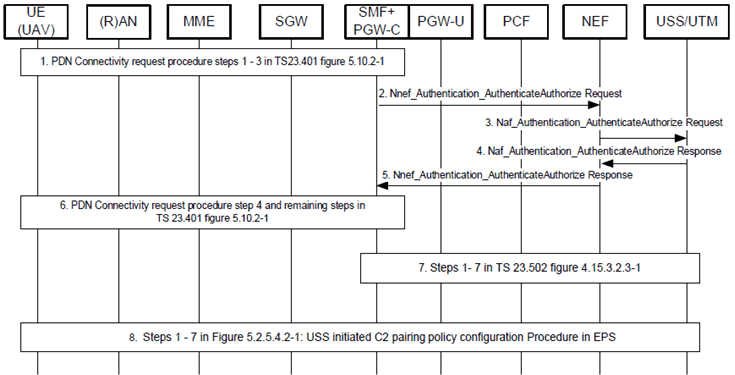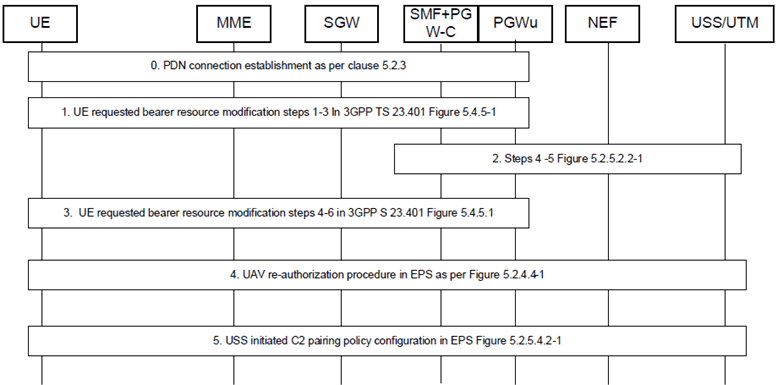Content for TS 23.256 Word version: 18.2.0
1…
4…
4.2…
4.3…
4.4…
4.5…
5…
5.2.3…
5.2.4…
5.2.5…
5.2.5.3…
5.2.5.4…
5.2.7
5.2.8…
5.2.9…
5.3…
5.4…
5.5…
6…
6.2…
6.3…
6.3.4…
5.2.5.3 Procedure for C2 authorization in EPS
5.2.5.3.0 C2 Authorization request during UUAA-SM procedure in EPS
5.2.5.3.1 UE requested PDN connectivity for C2 authorization
5.2.5.3.2 UE requested bearer resource modification of an existing PDN connection for C2 authorization
...
...
5.2.5.3 Procedure for C2 authorization in EPS p. 47
5.2.5.3.0 C2 Authorization request during UUAA-SM procedure in EPS p. 47
If C2 authorization is requested during the UUAA-SM procedure the procedure described in clause 5.2.3.3 takes place with the following additions:
- In step 0, the UE includes pairing information (if available) in a C2 Aviation Payload, which is forwarded further to the USS.
-
Initially in step 5, the USS performs C2 authorization taking into account the included pairing information, the Service Level Device Identity/CAA-Level UAV ID and 3GPP UAV ID/GPSI. The USS includes the resulting C2 Authorization result in the Naf_
Authentication_ response returned to the UAS-NF/NEF and UAS NF/NEF forwards to the UAV/UE in step 8.AuthenticateAuthorize -
The USS shall:
- in step 5 include a DN Authorization profile Index specifying a predefined set of PCC-rules in the PCF with initial restriction on the type of traffic allowed to pass on the PDN Connection. For example, only traffic exchanged with the USS might be allowed to pass. Once the authentication is complete, after step 5, the USS subscribes to PDN Connectivity Status Events for the PDN Connection used for C2 communication, applicable for the GPSI received in step 2.
- when the USS in step 9 receives a PDN Connectivity Status Event Report indicating session start and including the PDN Connection IP address, the USS invokes the USS initiated pairing policy configuration procedure (see Figure 5.2.5.4.2-1) with the received PDN Connection IP address and authorized paired UAV-C IP-address as input to request corresponding traffic to be allowed on the PDN Connection in the PGW-U.
5.2.5.3.1 UE requested PDN connectivity for C2 authorization p. 48
When the UAV requests to establish connectivity to an additional PDN over E-UTRAN for C2, the procedure described in clause 5.10.2 of TS 23.401 takes place with the following modifications:

Figure 5.2.5.3.1-1: UE requested PDN Connectivity for C2 authorization
(⇒ copy of original 3GPP image)
(⇒ copy of original 3GPP image)
Step 0.
The UAV has performed a successful UUAA with the USS (UUAA-SM) and the USS has for the corresponding GPSI subscribed for PDN Connectivity Status Event reports from the NEF.
Step 1.
Steps 1 - 3 performed as in Figure 5.10.2-1 of TS 23.401.
When the UAV needs to establish C2 communication, the UAV determines that a new PDN Connection is required for connectivity to UAV-C. The UE initiates a UE Requested PDN Connectivity procedure for connectivity to UAV-C. In the PCO in the PDN Connectivity Request, the Service Level Device Identity (e.g. the CAA-Level UAV ID) and a C2 Aviation Payload to be used for C2 authorization shall be included and forwarded to the MME. The pairing information includes the Service Level Device Identity (e.g. CAA-Level UAV IDs) of the requesting UAV and identification information for the UAV-C to pair may be included in C2 Aviation Payload. The UAV may also include other information such as Flight Authorization information. The USS may also use its locally configured pairing information for UAV - UAV-C pairing authorization which then takes precedence over UAV provided pairing information.
If Service Level Device Identity (CAA-Level UAV ID) is provided with the request, the SMF+PGW-C retrieves (if not already available) the Session Management Subscription Data for the UE from the UDM+HSS using the Nudm_SDM_Get service operation.
Step 2.
The SMF+PGW-C determines that authorization is required based on that the requested APN/DNN is dedicated for aerial services (have aerial service indicator set) and that the Service Level Device Identity (CAA-Level UAV ID) is included in the request. The SMF+PGW-C then sends a Nnef_Authentication_AuthenticateAuthorize request, which is used to request authorization to pair the UAV with UAV-C, to the UAS NF/NEF that includes the GPSI, Service Level Device Identity (e.g. the CAA-Level UAV ID) and C2 Aviation Payload and optionally the UAV location (e.g. Cell ID) if provided by the MME and the APN/DNN of the PDN Connection.
If the SMF+PGW-C determines that the authorization procedure with the USS is required, but the UAV has not provided the Service Level Device Identity (e.g. the CAA-Level UAV ID), the SMF+PGW-C rejects the PDN Connectivity Request with a cause indicating that USS authorization is required.
Step 3.
The UAS NF/NEF checks that a valid UUAA is stored for the GPSI and forwards the received authorization request as a Naf_Authentication_AuthenticateAuthorize request to the USS. If not, the request is not forwarded to the USS and the PDN connection is rejected.
Step 4.
The USS performs C2 authorization based on the received information and sends the Naf_Authentication_AuthenticateAuthorize response to the UAS NF/NEF including the Service Level Device Identity (e.g. the CAA-Level UAV-ID) (potentially new), the C2 Authorization Result and the C2 Authorization Payload (e.g. C2 pairing information and C2 security information).
Step 5.
The UAS NF/NEF forwards the information received from the USS in the Nnef_Authentication_AuthenticateAuthorize response sent to the SMF+PGW C.
Step 6.
To inform the UE about the C2 authorization result the SMF+PGW-C includes the C2 Authorization Result and optionally, the Authorization Payload (e.g. C2 pairing information and C2 security information) and a new Service Level Device Identity (e.g. CAA-Level UAV ID) if received from the USS, in the PCO in the PDN Connectivity Accept sent to the UE and let the PDN Connectivity Request procedure continue until finalized.
If a failed C2 authorization result is received from the USS, the SMF+PGW-C instead rejects the PDN Connectivity Request and includes a cause code indicating not authorized.
Step 7.
If the C2 authorization is successful the USS subscribes via the UAS NF/NEF to a PDN Connection Status Event report for the PDN Connection used for C2 including in the request the GPSI of the UAV. The UAS NF/NEF determines the APN/DNN and uses this APN/DNN to subscribe to SMF+PGW-C for PDN Connection Status Event. The SMF+PGW-C detects, as described in step 6-7 of Figure 4.15.3.2.3-1 in TS 23.502, when the PDN Connection is established and sends the PDN Connection Status Event report to the UAS NF/NEF by means of Nsmf_EventExposure_Notify message, including GPSI and UE IP Address. The UAS NF/NEF then forwards the event message to the USS.
Step 8.
The USS stores the received UE IP address and invokes, with the received PDN Connection IP address and the IP-address of the authorized paired UAV-C as input, the USS initiated C2 pairing policy configuration in EPS procedure (see Figure 5.2.5.4.2-1) to request corresponding traffic to be allowed on the PDN Connection by the PGW-U.
Unless a dedicated QoS is requested for the C2 flows, this procedure does not invoke any interaction with the UE, MME or RAN.
5.2.5.3.2 UE requested bearer resource modification of an existing PDN connection for C2 authorization p. 49
C2 authorization is requested at UE requested bearer resource modification (see clause 5.4.5 of TS 23.401):
- After UUAA-SM is performed and a common PDN Connection is used for connectivity to USS and C2 communication to a UAV-C (as configured in the UAV); or
- If the UE has already established a PDN Connection for C2 communication to a UAV-C.

Figure 5.2.5.3.2-1: UE requested bearer resource modification of an existing PDN connection for C2 authorization
(⇒ copy of original 3GPP image)
(⇒ copy of original 3GPP image)
Step 0.
The UE establishes a PDN Connection for USS communication as described in clause 5.2.3.
Step 1.
When the UAV needs to establish C2 communication, the UAV determines that an existing PDN Connection can be used and initiates a UE requested bearer resource modification procedure as Steps 1 - 3 in Figure 5.4.5-1 of TS 23.401. In the PCO in the request, the UE includes a Service Level Device Identity (e.g. CAA-Level UAV ID) and shall include a C2 Aviation Payload that includes C2 authorization information. The USS may also use its locally configured pairing information for UAV - UAV-C pairing authorization which takes precedence over UAV provided pairing information. The pairing information includes the Service Level Device Identity (e.g. CAA-level UAV ID) of the requesting UE and also includes identification information of UAV-C to pair if available. The UAV may also include other information such as Flight Authorization information.
Step 2.
The SMF+PGW-C determines that authorization is required based on that the APN/DNN of the PDN Connection is dedicated for aerial services (have aerial service indicator set) and that the Service Level Device Identity (CAA-Level UAV ID) is included in the request and then sends a Nnef_Authentication_AuthenticateAuthorize request to the UAS-NF including the UAS information provided by the UAV in step 1 (including the C2 Aviation Payload), the Service Level Device Identity (e.g. CAA-Level UAV ID), GPSI, PDN Connection IP address, and optionally the UAV location (e.g. Cell ID) provided by the MME.
The UAS-NF forwards the received authorization request as a Naf_Authentication_AuthenticateAuthorize request to the USS.
Step 3.
The UE requested bearer resource modification procedure completes as in Figure 5.4.5-1 of TS 23.401.
Step 4.
Triggered by step 5, the USS performs C2 authorization based on the received information and invokes, in order to forward the C2 authorization result to the UAV/UE, the UAV Re-authorization procedure (see Figure 5.2.4.4-1) including GPSI, Service Level Device Identity (e.g. CAA-Level UAV-ID) (potentially new) and, included in the authorization message, the C2 Authorization Result and the C2 Authorization Payload (e.g. containing C2 pairing information and C2 security information).
Step 5.
The USS invokes, with the received PDN Connection IP address and the IP address of the authorized paired UAV-C as input, the USS initiated pairing policy configuration procedure (see Figure 5.2.5.4.2-1) to request corresponding traffic to be allowed on the PDN Connection in the UPF/PGW-U.
Unless a dedicated QoS is requested for the C2 flows, this procedure does not invoke any interaction with UE, MME or RAN.